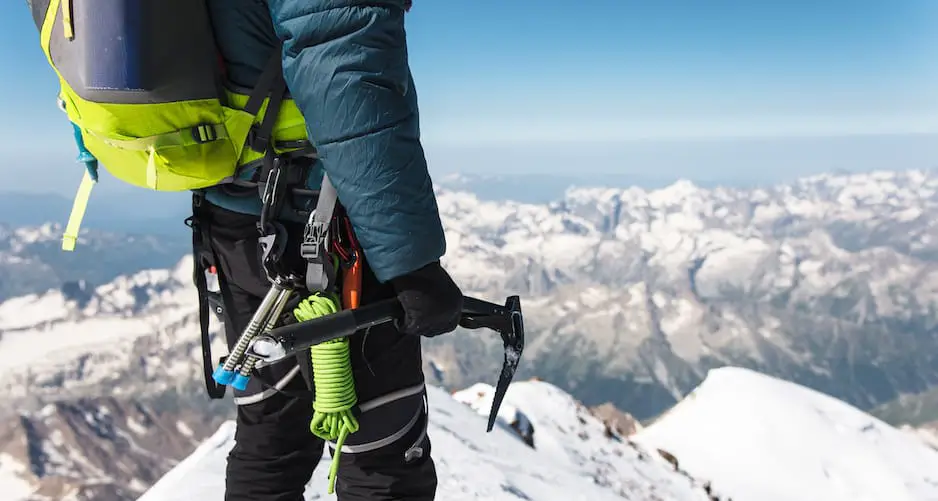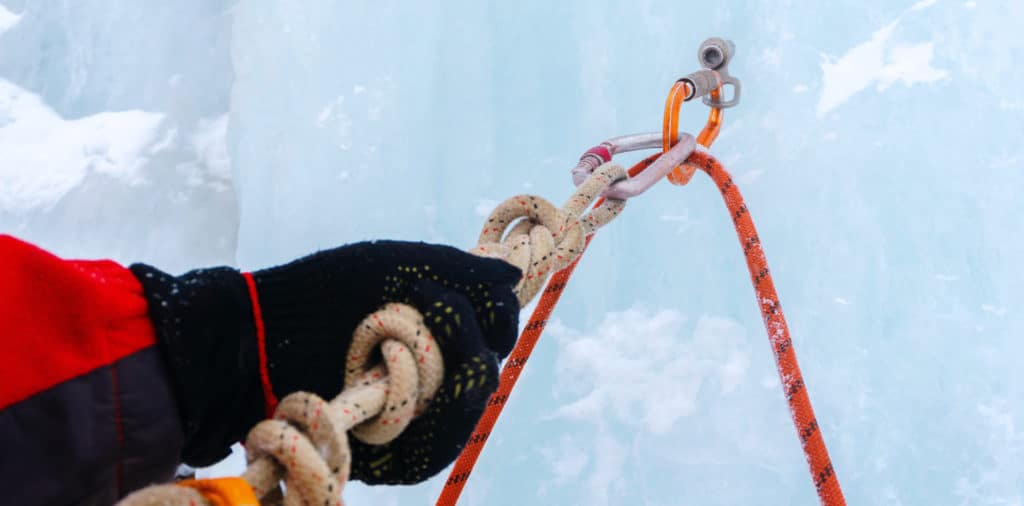
While choosing what I was going to wear ice climbing, I found myself wondering if it was okay to climb in mittens. I asked around and wrote the following guide to provide an answer.
So, can you ice climb in mittens? While it is possible to ice climb in mittens, you’ll lose a lot of dexterity in your hands. Because of that, thin gloves are usually used to hold your axes when you go ice climbing.
With that being said, however, there are still ways you can use mittens when ice climbing. They can be especially good to have when you’re belaying or waiting for your turn to climb, as their increased insulation will help keep your fingers warm. When it comes to climbing, however, mittens are often too bulky to properly climb in, and they don’t give you the degree of control you want on technical ice. Because of this, I would recommend using thin gloves for ice climbing and bringing a pair of mittens for when you need to belay.
Ice Climbing in Mittens
As I said, mittens aren’t the best option for ice climbing. Still, though, there is technically nothing preventing you from climbing in mitts. They’ll keep your hands warm, and as long as you can fit your hand into the grip of the ice axe, you’ll find yourself able to ice climb in them.
The important distinction, then, is to decide between what you can do and what you should do. There is physically nothing stopping you from using mittens to ice climb. Whether or not it’s the best option, however, is the real question that is being asked.
My answer is as above: no, you should not ice climb in mittens.
Remember, ice climbing is a highly technical and sometimes dangerous sport, especially if you’re leading. You need every advantage you can give yourself to avoid a fall.
One important element of this, obviously, is how well your ice axes are placed. Getting a good placement requires proper control of your swing. You also need to be able to ‘feel’ the placement out so that you can test if it’s secure before you weight it.
When you’re wearing gloves, it becomes harder to ‘test’ placements. The thick padding of the glove makes it harder to feel how your ice axe is placed, making it harder to judge whether or not it’s safe.
It also becomes harder to manipulate the axe, because the glove makes your hands and fingers unwieldy. This makes it harder to get a quality swing in. Getting an axe to stick into the ice requires the right degree of force, angle, and timing; all of these things are harder to execute when your fingers are blocked by the heavy padding of a glove.
Furthermore, aside from the strict mechanics of your swing, wearing gloves can get in the way of a whole bunch of other functions. Ice climbing isn’t just swinging over and over. You need to place screws, slings, and v-threads; you need to attach your gear and be able to tie into the rope; you have to manage a lot of clothing and equipment all at once.

All of these things require, to some degree, finger dexterity. Placing an ice screw is a pain in the ass if you can’t use your fingers, and there’s an increased chance that you’re going to fumble and drop them. That can both put you in danger of not having enough protection and cost you $100 to replace the screw.
Even when you’re not on the ice climb, there’s a danger to having mittens as your primary climbing glove. Some tasks, like tying a figure-8 follow through or putting your crampons on, simply can’t be performed while wearing mittens. That means that, to perform these tasks, you’re going to need to take your mittens completely off.
Taking your glove off exposes them completely to the elements, which can be uncomfortable in the best conditions and dangerous in the worst. Keeping your hands completely unprotected will cause them to cool down rapidly. This ruins your ability to grip tools, belay, and perform most of the other functions that are required to go ice climbing.
Because of that, wearing mittens is not a good idea, as you’ll sometimes be required to take them off so that you can perform other functions.
With that being said, however, there are some advantages to wearing mittens. They’re extremely warm, which can be a lifesaver on chilly days (and can increase your margin of safety, too). Because of this, I know a lot of ice climbers who like to wear their mittens while belaying or standing around, even if they’re not good for climbing. To do this, you want to use an effective layering system.
Layering System for Ice Climbing

Layering is the art of wearing multiple light-to-medium pieces of clothing on top of each other instead of one large piece. This creates the same amount of warmth, but gives you the ability to strip down when you get too hot (or when you need mobility) before layering back up when things get chilly.
For this specific question, layering would involve wearing multiple pairs of gloves. You would have smaller, more nimble gloves to use for ice climbing, knot-tying, and any other actions that required increased dexterity. Over top of that, you would wear a thick pair of mittens that you could pull on when you’re belaying or taking a break.
This system allows you to gain the benefits of mittens without having to experience any of their drawbacks. When you need to climb, or when you’re putting on your crampons or retying your laces, you can simply take the mittens off and enjoy being able to move your fingers. When it gets cold or you’re not moving as much, put the mittens back on.
Pro tip: bring a pair of hand warmers and stick them in your mittens. This will help re-warm your fingers after they’ve been exposed to the cold for a long period of time.
Also, make sure that whenever you’re not using the mittens, you store them inside your jacket. When you climb, your body creates a lot of heat that is then trapped inside by your out layers. Keeping your mitts here will keep them warm when they’re not in use. There’s nothing worse than getting to the top of a long climb and sliding your frozen fingers into a pair or ice-cold mittens.
Now that we know what layering is, let’s talk about a couple of different layering systems that I would recommend.
Warm Weather
Fair-weather ice climbing is the best ice climbing. There’s nothing like getting to enjoy the sport you love without having to contend with frozen toes, numb fingers, and wind-burnt cheeks.
Warm weather also means fewer layers. You can take advantage of this by bringing along a lighter pair of gloves, which means more control on the ice.
For this type of weather (anywhere from -7 to 0 degree Celsius), I would recommend wearing one thin pair of gloves for climbing in and one thicker pair of gloves or mittens for belaying in. This will allow you to stay comfortable when you’re resting while still enjoying the benefits of near-freezing temperatures.
Cold Weather

In cold weather, things get a little more complicated.
My primary concern when layering up for cold weather is to provide myself options. More choices mean more ability to optimize what I’m wearing. Choosing a glove is a trade-off between warmth and climbing ability, and I want to make sure I have the right pair of gloves for the job.
Because of this, I would recommend going with a three-glove system. I would bring the same light climbing gloves and warm mitten as above, because they’re good for year-round use. However, I would also bring an intermediary: a warm set of gloves that give you increased protection while still allowing for some finger dexterity.
This third pair of gloves can bridge the gap between the warm mittens and the light, flexible climbing gloves. Say it’s your first climb of the day, your hands are cold, and you don’t want to have to strip down to ultra-thin gloves for fear of getting hot aches. In this instance, the in-between gloves can be a life saver, and I would highly recommend them for any temperature of -7 or bellow.
